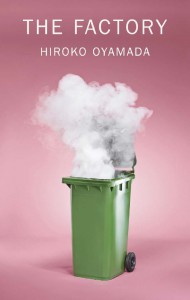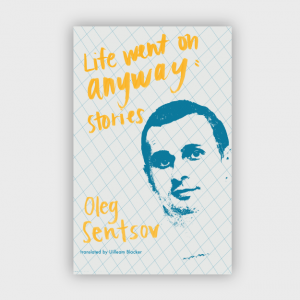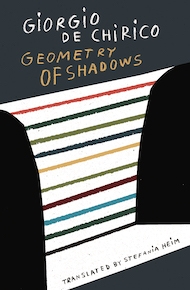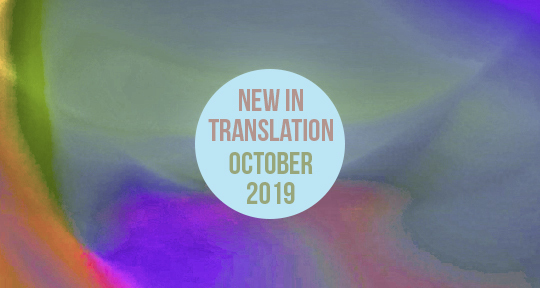A new month brings an abundance of fresh translations, and our writers have chosen three of the most engaging, important works: a Japanese novella recounting the monotony of modern working life as the three narrators begin employment in a factory, the memoir of a Russian political prisoner and filmmaker, as well as the first comprehensive English translation of Giorgio de Chirico’s Italian poems. Read on to find out more!

The Factory by Hiroko Oyamada, translated from the Japanese by David Boyd, New Directions, 2019
Review by Andreea Scridon, Assistant Editor
Drawn from the author’s own experience as a temporary worker in Japan, The Factory strikes one as being a laconic metaphor for the psychologically brutalizing nature of the modern workplace. There is more than meets the eye in this seemingly mundane narrative of three characters who find work at a huge factory (reticent Yoshiko as a shredder, dissatisfied Ushiyama as a proofreader, and disoriented Furufue as a researcher), as they become increasingly absorbed and eventually almost consumed by its all-encompassing and panoptic nature. Coincidentally wandering into a job for the city’s biggest industry, or finding themselves driven there—against their instincts—by necessity, the three alternating narrators chronicle the various aspects of their working experience and the deeply bizarre undertones that lie beneath the banal surface.
Central to the book is a process of immersion into this carefully constructed world of the factory, a surreally artificial community with shopping centers, forests, even a church: an entire universe in miniature, dedicated to a mission of production that has long since failed to represent anything for anyone involved, as depicted by the highly realistic dialogue between characters. Most memorable is the important presence of unrecognizable flora and fauna that hints at the possibility of an alternative dimension, though this is never fully followed up on. Take, for instance, a meta-text that Ushiyama proofreads on “washer lizards,” or lizards that eat lint and detergent, hatch their eggs in the factory’s washing machines, and sit on them as they thump rhythmically: “It looks as though they enjoy it.” The age-old metaphor of the flightless bird, reappearing consistently throughout the novella, is obvious but interpreted in a vivid and dark way, thus providing a new relevance for a classical trope and sublimating the pragmatic nature of the modern era: “They looked slick as oil, like if you wrung one by the neck you’d get black ink all over your hands.” Many passages have a similar air of enigma, allowing certain aspects to slip through the reader’s fingers. At any rate, one wonders if the book might be a cautionary speculation on the state of the future, and indeed the eerie postmodernity reminds the reader of Spike Jonze’s Her. Like much Japanese literature, the language itself is sparing (Oyamada is more utilitarian than a seeker of virtuosity) but the images are intense: “The boy’s sardine eyes were glowing, dead set on Doctor Moss.”
The active monotony of the industrial stillness, smelling slightly of existential horror, defies the traditional expectations one would have of a book; in other words, there is no plot, little actually happens, and it lacks a sense of drama—all unfortunately realistic aspects of working in a major corporation. In this sense, the novella (now making a comeback in publishing) is the perfect form for such a subject, as any longer description of this alienated landscape would have been dull. The decision to alternate first person narrators is striking: it requires precise execution, and Oyamada succeeds, as it is a vehicle for deliberate confusion, making for a trompe-l’oeil effect. Later, we do not know whether we are in a space of years or months (though the pacing is quite rapid and engaging), and reality is brought into question by way of this ambiguity. In a similar fashion, the genre of The Factory is somewhat difficult to pin down: decidedly experimental and subliminally philosophical, it best fits someplace between anti-capitalist science fiction and magic realism. Like other works of Japanese fiction that have recently become very popular in translation, it is intriguing and self-sustaining in its capacity to keep the mystery alive. Overall, The Factory proves to be an exacting, well-written work.

Life Went on Anyway: Stories by Oleg Sentsov, translated from the Russian by Uilleam Blacker, Deep Vellum, 2019
Review by Shelly Bhoil, Editor-at-Large for Tibet
“Writing is like pissing, you should do it only when you can no longer hold it in,” says Mikhail Zhvanetsky, whom Sentsov quotes in his memoir Life Went on Anyway, highlighting the compulsiveness of writing. Oleg Sentsov (b. 1976) is a Ukrainian filmmaker and a political prisoner of Russia, and this memoir is Sentsov’s second book, originally published from prison in 2015.
The translation of Sentsov’s memoir from Russian into English (to be published on October 15, 2019) is even more compulsive and urgent, for he was recently released from a twenty-year jail sentence on charges of terrorism that are widely believed, by people and organizations like Amnesty International, to be fabricated. His translator, Uilleam Blacker, evocatively describes Sentsov’s trial scene in the introduction of Life Went on Anyway, reminding one of the similar farce trial in Ngugi Wa Thiango’s anti-colonial play The Trial of Dedan Kimathi, and more recently, the Indian activist Vernon Gonsalves’s right wing-favored trial, where he was asked by the judge to explain why he had a copy of Leo Tolstoy’s War and Peace. Sentsov was tried as a Russian citizen, which he never was, and held guilty for possessing a DVD of the popular anti-fascist film Everyday Fascism. The rest of the story—the imposition of the new fascist law against all reason—is obvious. However, there is also hope: Sentsov was deservedly awarded the Sakharov Prize for Freedom of Thought by the European Parliament in 2018.
While one would expect Life Went on Anyway to be a political testament, it turns out to be a bildungsroman of sorts, tracing Senstsov’s formative years before and after the Soviet Union. The memoir runs through seven chapters, each centered around memorable events or people in his life, ultimately leading to valuable lessons. The first story, “Dog,” for instance, which tells of how Senstov came to terms with the loss of his father after the loss of his second dog, and in turn learned to grieve death through the act of burying his dog, is also a lesson in kindness and love. He writes:
All our kindness is instilled in us in childhood. It’s the gentleness of our mothers and the hands of our fathers, it’s our friends, it’s fairy tales and books. It’s the cartoons we watch. In the little mammoth swimming toward his mum in the ice floe there’s more kindness than in all the charitable organizations put together!
Not just an evolution towards compassionate human spirit, Life Went on Anyway is also about Sentsov’s maturing up to boyhood, even including sexual maturation with a gang of young, male patients in a sanatorium, which he calls “a little, soft school of life” in a passing reference in the story titled “Hospital.”
In “Testament,” I sense an intellectual evolution of Senstov, somewhat in the spirit of Edward Said. Like Said, the exiled intellectual, this political prisoner wishes to be disengaged with fossilizing romantic tropes, even in his death. Instead of being buried and remembered as a “portrait on a slab of granite,” he wishes to be burned, and his ashes to be spread on the wind, and even the urn to be washed away in the sea so that when nothing is left, there are just memories of the things he did.
The pace of the book’s narrative synchronizes with the content in ways that keeps the reader attentive. For instance, the fast rhythm of short sentences and frequent punctuation in the chapter “Childhood,” when recalling the height of football passion at the age of thirteen, couldn’t come better than in the act of lacing up football trainers quickly but also carefully, which builds up a tension because “a minute spent tying laces seems like an hour” before “the last knot—and I am ready.” Likewise, the conversational and informal tone of the narrative slides with ease into poetic prose when describing his childhood’s idea about the world being “a large bowl, lined at the edges by mountains, hills, and fields” beyond which “the sun had its nighttime life.”
One thing that makes Life Went on Anyway especially endearing is Sentsov’s terrible sense of humor on every second page. Take for example his flippant proposal to his loved ones to fetishize his favorite or last worn socks and underwear instead of the standard urn after he is gone! One gets the seriousness of humor, its therapeutic and satirical roles, upon realizing that jokes have made room in the somber confines of prison walls. This is the reason why Life Went on Anyway is a must-read testimony of the indomitable human spirit that is beyond the reach of fascist regimes. The translation of this memoir into English is a deserved celebration of this unwavering human spirit against all odds.

Geometry of Shadows by Giorgio de Chirico, translated from the Italian by Stefania Heim, A Public Space, 2019
Review by Garrett Phelps, Assistant Editor
Once a friend asked what book I was reading, so I directed him to the back cover where a short biography summed up the author’s achievements, most of which were in the visual arts. Any literary efforts, limited to a lost novel and a couple books of lyric poetry, were discussed as a curiosity in his oeuvre. Side-eyeing me, my friend said: “That’s never a good sign.”
And to be fair, it often isn’t. With respect to the book in question, it definitely wasn’t; I burst into a frazzled defense which, looking back, wasn’t of the book itself but the fact that I had wasted two days reading it. Obviously visual artists aren’t inherently bad poets, while many poets, on the other hand, are. Still, a lot of unfair skepticism surrounds painter-poets. At best, we appreciate their writing strictly in light of the visual work, but nevertheless give it an “A” for effort. At worst, they look like amateurs whose scribblings only escape the trash can thanks to an established reputation. An artist like Giorgio de Chirico is big enough that even if his poems were garbage, they would survive. That said, they’re not garbage at all. Geometry of Shadows is the first English-language collection of his Italian poetry, translated by Stefania Heim and published this month by A Public Space.
De Chirico invented much of what we associate with the visual branch of surrealism, particularly the illogical juxtaposition of objects in abstract landscapes. His art is heavy on—if not consisting completely of—metaphor, and frequently referred to as poetic, understood in the loose sense that it shuns appearances and forsakes literality. None of this is a good forecast for whether or not de Chirico’s poetry will be a flop. It isn’t, as I said, although it does bear marks, both good and bad, of a visual mind orienting itself toward the written word: a promiscuous use of strong imagery, and waves upon waves of metaphors at the expense of a more nimble and protean style. These qualities often typify the poetry of amateurs, but such strict standards are for tastes limited to Harold Bloom anthologies. Equally unbridled are the first surrealist poems of Louis Aragon or André Breton, who at one time was an almost fanatic de Chirico devotee. Has anyone since 1925 called either of them a dabbler? Rather than being a footnote to a great twentieth century artist, Geometry of Shadows, as Stefania Heim’s introduction (published previously on the Asymptote blog) puts it, approaches de Chirico “not as a painter who happened to write, but as a poet.”
De Chirico’s poetry achieves that rare ideal of feeling spontaneous and well tempered in equal measure. Short staccato lines turn into paragraph-length blocks of prose, and even though imagery floods the page at a constant rate, the space in which it’s contained is malleable. This extract from the poem “Promontory” is a good sample of his style:
Profundity and solitude have finally left the oceans unfathomed. Amphibians with sensitive skin wrapped in a net of strange shivers now slither through the tepid waters of the ports. In those waters bounded by burnt and solid land and by industrial buildings. Waters that don’t stupidly reflect the superimposed landscape because they are fully colored by the boiling sulfurous cascades that pour down continually from the smoking rocks of the coast.
Gentlest outlets of telluric bile.
In that fecund heat made of the steamy sulfurous afternoon the work soaked in bitter sweat is born from a thousand throbs.
To accompany this happiness of mine the most perfect reliefs form along the walls of my room.
The word “painterly” always seems trite, but it is an honest descriptor for de Chirico’s process, where every stanza provides a sense of scale but also of how far space stretches, like a vanishing point, beyond our line of sight. “The word for room in Italian is stanza,” Heim tells us, “and it seems inevitable that the stanzas of poems would house de Chirico’s ‘metaphysical interiors,’ becoming a container for his wild and domestic musings across space and time.” To the ear and off the tongue, de Chirico’s language feels as extensive as the space it occupies. This style is fiercely his own and Stefania Heim gets it into English beautifully, a point for which this book may deserve the most applause. If I had to say something critical, it’s that de Chirico’s exclamations (“O sweetness!”) feel a bit outdated even for his era, but that’s all I want or even can say against these poems.
*****
Read more reviews on the Asymptote blog:

